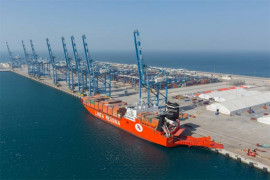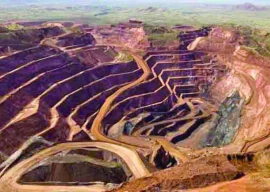
Pakistan has once again decided to seek Chinese interest in the multi-billion-dollar Diamer Bhasha dam project, which is facing a $3.5 billion financing gap—a move that indicates Saudi Arabia has not selected the project for its investment.
Government sources told The Express Tribune that Prime Minister Shehbaz Sharif has instructed the Ministry of Planning to make the Diamer Basha dam project part of the China Pakistan Economic Corridor (CPEC). Under CPEC, China has already invested $28 billion in Pakistan in infrastructure and energy projects.
The instructions were issued days before a scheduled 13th meeting of the Joint Cooperation Committee—the highest decision-making body of CPEC—which is virtually taking place today (Friday).
The scheduled two-hour JCC meeting will be held via video link to review overall CPEC progress and discuss future projects. The Pakistani side will be led by Planning Minister Ahsan Iqbal, while China will be represented by Vice Chairman of the National Development and Reform Commission (NDRC) Li Chunlin.
The 11 joint working groups of CPEC will each have five minutes to discuss progress and future prospects. The four provincial chief ministers, prime minister of Azad Jammu and Kashmir (AJK), and chief minister of Gilgit Baltistan will each have three minutes for their speeches.
CPEC has been stalled due to Pakistan’s inability to meet sovereign commitments and its failure to devise marketable policies to attract private Chinese investment in the industrial sector.
Sources said the PM gave these instructions during a meeting a few days ago to finalise his visit to Beijing and address pending issues faced by Chinese companies working in Pakistan. The PM is visiting China from June 4th to 7th.
This is the second time in seven years that Pakistan has decided to include the Diamer Basha dam project in CPEC. In November 2017, Pakistan withdrew its request to include the project in the CPEC framework after Beijing imposed strict conditions, including ownership of the project, said Muzammil Hussain, the then-chairman Water and Power Development Authority (Wapda).
Read Rivers swell from glacier melting
The former Wapda chairman had said that Chinese conditions were about taking ownership of the project, operation and maintenance cost and securitisation of the Diamer-Bhasha project by pledging another operational dam.
Last month, Pakistan offered the Diamer Basha dam project to Saudi Arabia for equity partnership, seeking $1.2 billion in equity investment and $2.3 billion in debt for 10 years.
The project is facing a $3.5 billion financing gap. Pakistani authorities were hopeful that Saudi Arabia would pick the project as part of its $5 billion investment in Pakistan. However, the government has not yet formally received a response from the Saudi authorities, said a senior government official.
The Diamer Basha dam project is being constructed with a 30% equity and 70% debt ratio. The dam will generate around 18 billion units annually, with a capacity of 4,500 megawatts of electricity and a storage capacity of 6.4 million acre-feet of water. Pakistan has already begun work on the dam part of the project.
The prime minister has also instructed the use of Gwadar port for imports by public sector companies. However, the port is not fully functional due to missing infrastructure links. Many efforts have been made to expand the port’s operations.
Despite the lapse of many years, Pakistan has not been able to get the Gwadar Free Zone land vacated from the Navy and Pakistan Coast Guard.
The PM also instructed the framing of a policy to relocate Chinese textile and other labour-intensive industries to Pakistan to increase exports. However, these instructions have remained unimplemented for nearly a decade.
In the meanwhile, China did not wait for Pakistan and has already started relocating the industries to other regional countries.
Due to Pakistan’s failure to develop Special Economic Zones (SEZs) for Chinese industries, surplus electricity generation capacity has become one reason for expensive power.
The planning ministry said on Thursday that industrial cooperation is crucial for the second phase of CPEC’s high-quality development. The CPEC Framework Agreement on Industrial Cooperation has been signed, and efforts are being made to populate the Rashakai SEZ, Phase-I, with Chinese and other enterprises, it added.
Pakistan has decided not to seek more Chinese investment in the public sector, except for the $6.7 billion Mainline-I project of CPEC and hydropower projects.
On Wednesday, Islamabad referred the ML-I project to a higher body for approval amid the Ministry of Finance’s concerns about conflicts with the next International Monetary Fund (IMF) programme.
The PM also instructed the planning and finance ministries to address lingering payments of around Rs530 billion to Chinese power producers. He asked the Ministry of Finance to review financial space for releasing some of the delayed payments to Chinese power producers. Chinese companies have begun demanding Pakistan place funds in offshore bank accounts for energy debt repayments due to its weak financial position.
Published in The Express Tribune, May 24th, 2024.
Like Business on Facebook, follow @TribuneBiz on Twitter to stay informed and join in the conversation.
























COMMENTS
Comments are moderated and generally will be posted if they are on-topic and not abusive.
For more information, please see our Comments FAQ